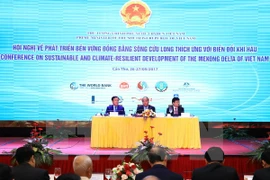The statement was made at aconference on solutions to limit global warming held between the Ministry ofNatural Resources and Environment and non-governmental organisations on October5.
Nguyen Van Huy, arepresentative of the ministry’s Department of Climate Change, said that Vietnam’sdevelopment towards becoming an industrialised country has increased impacts onthe climate, especially greenhouse emissions.
In 2013, emissions were 3.5times higher than in 1991, and are forecast to triple by 2030 compared to 2010.
Thus, the country has setup and implemented climate change mitigation policies to gradually shift thedomestic economy towards a low-emission growth path.
Huy said the VietnameseGovernment has committed to reducing greenhouse gas emissions by 8 per cent, to25 per cent with domestic resources only or with international finance as partof efforts to limit global warming to below 2 or 1.5 degrees Celcius.
Currently, authorisedagencies are focusing on the evaluation of greenhouse gas emissions in manyfields.
Huy said experience and lessonsshared at the conference would help the country succeed in achieving itstarget.
Julia Balanowski, anindependent consultant, said that Vietnam seemed to pay too little attention tomitigation actions that might benefit the most disadvantaged and vulnerablepeople.
She said that 70 per centof the world’s population still lived in poverty, and many in rural areas faceda high number of blackouts and shortages of clean water and adequatesanitation.
Living on the edge ofpoverty, these people had very low per-capita emissions, which was much lessthan those in industrialised countries. However, they were the most affected interms of development disadvantages and low resilience to the impacts of climatechange.
She cited that in manycases, subsidies for energy projects or reforestation take land away fromagriculture, seriously affecting incomes and agricultural production of localpeople. In some other cases, local residents were displaced to serve suchprojects.
Balanowski said thatpoliticians and citizens needed to understand the links between mitigationactions and the welfare of the poor and most vulnerable in Vietnam. This wouldbe essential for the sustainability of any mitigation actions.
Vu Minh Hai, chairwoman ofthe NGO Climate Change Working Group, said that Vietnam needed a portfolio ofclimate change adaptation and mitigation measures.
She explained that therewere differences and trade-offs between adaptation and mitigation. For example,some adaptation measures could increase emissions such as the construction ofsea dykes, which degraded mangroves or reduced carbon sinks.
Meanwhile, mitigationactions could reduce adaptive capacity. For example, a project of investing inrenewable energy or large scale reforestation would lead to displacement ofpopulations and threaten local food production.
Hai said industrialisedcountries needed to uphold their ecological debt towards countries such as Vietnam,and vulnerable groups should have the opportunity to pursue mitigation as anoption.
At the conference, expertssuggested that Vietnam should consider fairness and equity in climate changemitigation activities such as developing a set of poverty-focused measures andstarting common dialogues about sustainable development for all involved.
Policies in climate changemitigation, adaptation and development strategies needed to be discussed andplanned in conjunction with each other to ensure inclusiveness.
The country also needed toimprove government resourcing to build institutional capacity, createsupporting schemes for the poor to implement green agricultural technology orbiotechnology.-VNA





























